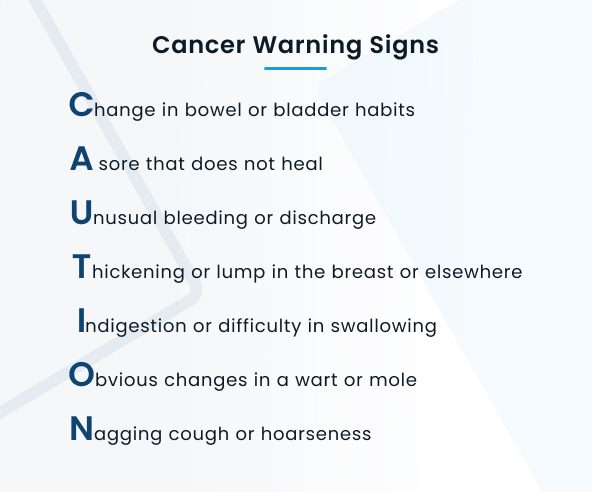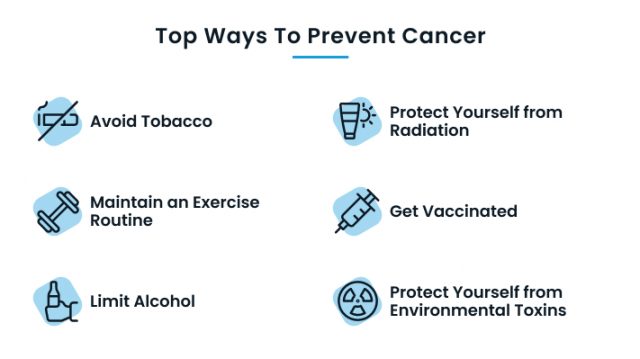Preventing Cancer
Some of the most effective steps in cancer prevention involve simple changes in habits or lifestyle, such as eating a healthy diet, quitting cigarettes and avoiding toxic substances. Scheduled cancer screenings and seeing a cancer specialist can also help you prevent avoidable cancers.

Cancer Causes & Risk Factors
An estimated 600,000 people in the United States die from various cancers each year, but at least 33% of cancer deaths are preventable.
There are many causes for cancer, such as asbestos and other environmental hazards or toxic substances, including alcohol and tobacco. People develop cancer at different rates, and certain risk factors may make them more susceptible to specific types of cancer.
Some smokers may never develop lung cancer, while others could have a genetic trait in their DNA that increases their risk. Smoking is a cause of cancer, but risk factors, such as medical history or DNA traits, increase the chance of developing that cancer.
- Dietary Influences:
-
Alcohol and red meat consumption directly contribute to an increased risk of gastrointestinal cancers, especially if there is an underlying GI issue.
- UV Radiation:
-
Direct exposure to sunlight can cause skin cancer, and certain risk factors, such as pale skin, increase the risk of developing cancerous moles or lesions.
- Airborne Substances:
-
Smoke, dust, particulates such as asbestos and other airborne pollutants are causes of respiratory cancers. The risk is higher for people with chronic respiratory illnesses, such as COPD or asthma.
- Familial Cancer:
-
Genetic mutations in DNA, such as the BRCA gene, can cause cancers randomly without other risk factors. For example, a family history of breast and ovarian cancers increases the risk of those cancers for other family members.
Cancer prevention methods are essential for people with environmental, lifestyle or genetic risk factors. Alcohol consumption contributes to roughly 5% of cancers but is a behavior many people can modify to reduce that risk.
Understanding how to prevent cancer by identifying causes and risk factors is vital for reducing the 13,000 avoidable cancer deaths caused by sun exposure, poor diet, smoking and other preventable habits.
How Can You Prevent Cancer?
Recognizing the early signs of disease is an effective method of preventing cancer from developing or worsening. Whenever you have new or worsening symptoms or a change in your baseline health, it’s crucial to speak with your physician about how to prevent cancer and when to get tested.
An early cancer diagnosis allows for the best treatment options before tumors have grown and spread throughout the body. For example, nearly 100% of people with an early breast or prostate cancer diagnosis live for five years or longer. Not every cancer causes symptoms, but you should still speak with your provider if you have concerns or worries about your cancer risk.
Cancer symptoms vary depending on where cancer develops in your body and which organs are affected. Some cancers also mimic more common illnesses, such as the cold or flu. The acronym C.A.U.T.I.O.N. can help you recognize the potential early signs and symptoms of cancer.

Discussing your symptoms with your doctor helps them identify where tumors may be developing. For example, a cough or difficulty swallowing may indicate cancer in the head, neck or thoracic region. Keeping track of a skin lesion is an excellent method of catching skin cancer early. An early diagnosis of melanoma skin cancer has a 5-year survival rate of 99%.
For patients without symptoms, regular screenings are another method of identifying cancer early and preventing advanced disease. Doctors will perform tests and imaging exams during a screening appointment based on cancer-specific risk factors, for example, a prostate exam for men over 50.
One of the most effective cancer prevention methods is modifying personal behaviors such as wearing sunscreen and being aware of potential carcinogens, substances and materials that cause cancer. When dealing with high-risk materials, such as asbestos or benzene, using protective equipment can drastically lower your chance of developing cancer.
Cancer Screenings and Self-Exams
Cancer screenings detect cancer once it’s formed but can’t prevent cancer from developing in the first place. However, screenings are essential in finding cancer early and preventing it from growing and spreading in later stages.
The American Cancer Society estimated that doctors would diagnose 248,530 new cases of prostate cancer in 2021, but only 35% of the eligible population received prostate screening tests in the past year. Similarly, 8 million smoking adults were eligible for lung cancer screening in 2018, and about 4% received the early detection test known as low-dose CT imaging.
Early tumor detection improves prognosis and life expectancy. For example, 92% of patients diagnosed with stage IA1 lung cancer, the earliest stage, live for at least five years. Comparatively, only 68% of patients diagnosed at the end of stage I, known as IB, live for five years or more.
| Screening Test | Cancer Detection | Eligible Patients | Importance | Frequency |
|---|---|---|---|---|
| Low-dose CT | Lung | Adults 55-74 with a history of smoking | Detects lung abnormalities in patients who recently quit or had an extensive smoking history | Yearly |
| Colonoscopy | Colon | Adults over 45 | Can identify polyps or growths using a small camera and remove tissue samples for biopsy testing | Every 10 years |
| Mammography | Breast | Women over 45 | An x-ray exam reveals lesions in the breast before they become too large for surgery | Yearly but may continue every two years after age 55 |
| Pap + HPV test | Cervical | Women over 30 | HPV is an infection that can directly cause cervical cancer, and a pap smear identifies abnormal cervical cells | Every five years |
| Prostate-Specific Antigen | Prostate | Men over 50 | This blood test detects an early biomarker of prostate cancer | Yearly for men with a high PSA or every two years if PSA is low |
Screening tests may differ for patients based on risk factors or medical history. For example, patients at a higher risk for colon cancer may also undergo a stool DNA test every three years, a CT colonoscopy every five years or a fecal occult blood test every year.
Understanding cancer and your familial risk of a genetic predisposition in your DNA can help you identify when to begin screening exams. Prostate cancer has one of the highest rates of familial risk at over 20%, followed by 13.58% for breast cancer and 12.8% for colorectal cancers.
If you are concerned about your cancer risk and want to know how to prevent cancer, don’t be afraid to ask your doctor questions or seek a second opinion. Your doctor should have a complete picture of your family history, overall health, and potential risks to prevent cancer from developing or worsening.
Avoid Tobacco
Smoking causes roughly 20% of all cancer types and is responsible for 30% of cancer deaths in the United States. Tobacco significantly affects cancer risk and is linked to 80% of lung cancer diagnoses and deaths, the deadliest cancer in men and women.
Your doctor can provide you with several resources and methods for quitting cigarettes and tobacco. They will also work with you to develop an outline of your smoking cessation plan.
- Planning and using goals to stop smoking on a scheduled date
- Decreasing tobacco and nicotine through e-cigarettes
- Therapy or counseling to overcome the mental addiction
- Nicotine replacement therapy
- Prescription medications
In addition to causing lung cancer, smoking tobacco also increases the risk for many additional cancers, including kidney, liver, bladder, pancreas, stomach, colon and cancers of the head and neck. Smoking can also increase the risk of cancers caused by environmental carcinogens. Smokers exposed to asbestos have an elevated risk of malignant pleural mesothelioma.
Quitting a tobacco addiction is mentally and physically challenging, but it’s one of the most effective ways to prevent cancer. According to the US Surgeon General on how to prevent cancer, “Smoking cessation represents the single most important step that people who smoke can take to enhance the length and quality of their lives.”
Maintain a Healthy Diet and Exercise Routine
A well-balanced diet helps improve energy levels and control weight. Maintaining a healthy weight with proper nutrition significantly reduces cancer risk. Doctors diagnose more than 650,000 obesity-associated cancers in the U.S. each year. Breast and colorectal cancers are two of the most common obesity-associated cancers.
Fad diets, such as the keto or ketogenic diet, can often have adverse long-term effects. Healthy diets focus on nutrient quality and avoiding high-calorie and sugary foods. Harvard’s Healthy Plate Guide suggests eating primarily vegetables and fruits that vary in color, whole grains such as quinoa and barley, and protein sources such as fish, beans and poultry.
Regular exercise is just as vital as nutrition for cancer prevention and can reduce pain and anxiety while increasing energy and strength. Your doctor can help you personalize an exercise routine based on your tolerance and health. Remember that rest days are essential, and patients with respiratory cancers such as mesothelioma should be cautious with activity.
Limit Alcohol
Research indicates potential health benefits to moderate alcohol consumption, typically one to two drinks per day. For healthy adults, limited alcohol use may reduce the risk of diabetes, heart disease or stroke. Your doctor can advise you on how much alcohol is advisable. However, there are significant risks to consider, including the risk of cancer.
In 2020, alcohol consumption contributed to an estimated 741,300 cancer cases globally. Your body breaks down alcohol into a carcinogen called acetaldehyde, which can damage DNA and form tumors. Limiting alcohol intake from beer, wine, and liquor can improve cancer prevention of liver, colon, mouth, and throat cancers.
Protect Yourself from Radiation
Skin cancer caused by ultraviolet radiation from the sun is the most common cancer globally and within the United States, killing more than two Americans every hour. One in five people in the U.S. will develop skin cancer by age 70, but almost everyone with an early diagnosis survives at least five years.
- During the sunniest parts of the day, seek shade and overhead coverings.
- Wear clothes that minimize skin exposure and cover your arms and legs.
- Wearing a hat with a wide brim will shade your face, ears and neck from UV rays.
- Use sunscreen with a sun protection factor (SPF) of 15 or higher.
Other sources of radiation are more invisible but can also cause devastating cancers. Radon is a natural, radioactive gas found in underground rocks and soil. Radon gas can enter buildings and homes through the ground, causing lung cancer over several years. Occupational radiation exposure is also a risk for professionals such as radiology technicians and power plant workers.
Protect Yourself from Environmental Toxic Substances
Unlike radon, many carcinogens exist in the environment without being radioactive. For example, asbestos fibers originate from naturally occurring minerals. When damaged and split into microscopic airborne fibers, asbestos becomes easily inhaled and trapped in the body, causing lung cancer and mesothelioma to develop over several decades.
Other environmental toxic substances include benzene, vinyl chloride and arsenic, present in various household chemicals and materials. These chemicals are cancer-causing in high concentrations, especially in work environments with unsafe practices, such as inadequate ventilation and protection equipment.
When dealing with potentially dangerous materials, read warning labels and participate in work hazard training. Be aware of carcinogenic substances in your workplace, and use personal protective equipment as directed.
Get Vaccinated
Vaccinations against some diseases can help prevent cancers that develop because of those infections. Notably, the hepatitis B vaccine can block chronic hepatitis infections that lead to liver cirrhosis and cancer. The flu and pneumonia vaccines prevent severe diseases, which can be deadly for cancer patients.
Another common vaccine is the HPV vaccine which protects against the human papillomavirus. This virus is a leading cause of cervical cancer and many other cancers. Every year, the HPV vaccine helps prevent an estimated 33,000 cases, or over 90%, of cancers caused by HPV, including cervical, oropharyngeal, anal and genital cancer.
Several vaccines are available for cancer prevention in the same way they prevent or limit infectious diseases such as the flu and hepatitis. Vaccines against mesothelioma and breast cancer are undergoing clinical trials to determine safety and effectiveness. If approved, they could prevent cancer recurrence for many patients.
Can All Cancers Be Prevented?
Not every cancer is preventable because DNA and genetics play a role in a person’s risk of developing cancer. If a parent carries a gene with a mutation that makes them susceptible to cancer, each child has a 50% chance of inheriting that cancer susceptibility gene.
However, not everyone with a genetic predisposition to certain types of cancer will get that cancer. Hereditary cancers with familial risk are relatively rare, about 5% to 10% of all cancers, and often explained by shared behavior patterns, such as smoking, or environmental exposure, such as asbestos.
Fortunately, cancer prevention for most cancers is achievable through changes in lifestyle or safety behaviors. A cancer specialist can assist in determining which cancers pose the most significant risk to you based on your medical and work history, lifestyle, environment and genetic factors.

Finding a Cancer Specialist
Cancer specialists are doctors who have extensive training and experience treating specific types of cancer. For example, a thoracic oncologist specializes in chest cancers, such as lung cancer and mesothelioma. This type of doctor has advanced knowledge of how to prevent cancer and uses the most recent techniques and medical practices for their specialty.
The benefits of seeing a cancer specialist include more options when it comes to treatment. For example, a cancer center specializing in brain cancer will have multiple clinical trial opportunities specific to brain cancer patients. Specialists also typically work in multi-disciplinary teams that involve surgeons and radiologists.
Getting in touch with a specialist is essential for rare cancers since receiving an early and accurate diagnosis is more challenging. Ask your physician for a referral to a specialist, and don’t be afraid to look for a second opinion. The Pleural Mesothelioma Center helps connect mesothelioma patients with specialists who provide personalized and advanced care.

